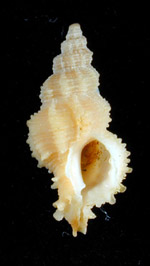|
|
The
Muricidae includes many large, spectacularly spined and delicately
fronded species which are favourites with collectors. But more numerous
in the family are small and medium sized species, less ornately
sculptured, which are common on rocky shores and in estuaries. The
family is divided into a number of subfamilies, all of which are
represented in the NSW fauna.
The
species of the subfamily Muricinae, which have elaborately spined and
fronded varices, are mainly tropical, but a few species occur in NSW.
The more spectacular of these live subtidally and are only found in good
condition when occasionally taken by scuba diver. In the subfamily
Muricopsinae varices are also present, but are generally low, thick and
short spined. Four species of this subfamily also occur in NSW, all
uncommon to rare. In contrast, species of the subfamily Ergalataxinae,
commonly known as Oyster Drills, are more common. They are small to
medium in size, and lack varices. They occur on rocky and sheltered
shores intertidally and subtidally, two species being quite common in
oyster beds.
Species
of the subfamily Typhinae are distinguished by a closed siphonal canal
on the shoulder. In NSW they are rarely encountered, as they occur
subtidally, down to 600 m in depth. One large and several small species
occur locally. Shells of the Trophoninae are also obtained from deep
water, and are relatively poorly known. They are distinguished by
numerous laminate varices and a long siphonal canal. Two large species
have recently become available from commercial trawling on the
continental slope of south-eastern Australia.
The
subfamily Rapaninae was previously known as Thaidinae or the separate
family Thaididae. In this subfamily shells are smooth, nodulose or
spinose, but lack varices, and have a distinctive ridged operculum. The
common name of `rock shells' is indicative of their habitat among rocks
and coral where they frequently become heavily encrusted with marine
growth. The subfamily is represented in NSW by several common intertidal
species, including the ubiquitous mulberry shell and the cartrut shell.
Muricids
are carnivorous, some species obtaining food by drilling a small
circular hole in the shell of their prey. On rocky shores in NSW species
of this family, particularly the mulberry whelk Morula marginalba,
are important predators on mussels, barnacles and other sessile animals.
Family
References:
-
D'Attilio,
A. & Hertz, C.M. 1988. An illustrated catalogue of the family
Typhinae Cossmann, 1903. Festivus, Supp. 20: 1-73.
-
Houart,
R. 1992. The genus Chicoreus and related genera (Gastropoda:
Muricidae) in the Indo-West Pacific. Memoires du Museum National
d'Histoire Naturelle (A) 154: 1-188.
-
Kool,
S.P. 1993. Phylogenetic analysis of the Rapaninae (Neogastropoda:
Muricidae). Malacologica 35(2): 155-259.
-
Ponder,
W.F. 1972. Notes on some Australian genera and species of the family
Muricidae. Journal of the Malacological Society of Australia
2(3): 215-248.
-
Ponder,
W.F. & Vokes, E.H. 1988. A revision of the Indo-West Pacific
fossil and recent species of Murex s.s. and Haustellum (Mollusca:
Gastropoda: Muricidae). Records of the Australian Museum
Supplement 8: 1-160.
-
Radwin,
G.E. & D'Attilio, A. 1976. Murex shells of the world. An
illustrated guide to the Muricidae. Stanford University Press:
Stanford.
Coverage
In
addition to the species described in detail, the following are recorded
from NSW:
Large,
deep water species restricted to north-eastern Australia:
-
Pterynotus
patagiatus (Hedley, 1912). Living specimens from Three Is, Qld,
to Bunker Group, Qld. Holotype from Sydney Harbour, probably
subfossil. Length up to 54 mm.
Species
widespread in the tropical Indo-West Pacific, uncommonly occurring in
northern NSW:
-
Aspella
anceps (Lamarck, 1822) (Synonym Aspella ponderi Radwin
& D'Attilio, 1976). Indo-West Pacific, to Sydney, NSW. Length to
14 mm.
-
Chicoreus
territus (Reeve, 1845). Central Indo-West Pacific to Sydney.
Length to 70 mm.
-
Cronia
margariticola (Broderip, 1832). Indo-West Pacific to Angourie,
NSW. Length to 46 mm.
-
Drupa
ricinus (Linnaeus, 1758). Indo-West Pacific, to Solitary
Islands, NSW. Length to 31 mm.
-
Drupa
rubusidaeus Roding, 1798. Indo-West Pacific, to Solitary
Islands, NSW. Length to 55 mm.
-
Drupella
cornus (Roding, 1798). Indo-West Pacific, to Solitary Islands,
NSW. Length to 46 mm.
-
Drupella
rugosa (Born, 1778). Indo-West Pacific, to Iluka, NSW. Length to
35 mm.
-
Habromorula
lepida Houart, 1994 (Synonym Morula dumosa (Conrad,
1837). Indo-West Pacific to Solitary Islands, NSW. Length to 15 mm.
-
Homalocantha
anatomica (Perry, 1811). Indo-West Pacific, to Solitary Islands,
NSW. Length to 54 mm.
-
Lataxiena
fimbriata (Hinds, 1844) (Synonym Lataxiena lataxiena
Jousseaume, 1883). Indo-West Pacific to Port Stephens, NSW. Length
to 53 mm.
-
Morula
anaxares (Kiener, 1835). Indo-West Pacific, to Angourie, NSW.
Length to 17 mm.
-
Morula
spinosa (H. & A. Adams, 1853). Indo-West Pacific, to
Solitary Islands, NSW. Length to 30 mm.
-
Morula
uva (Roding, 1798). Indo-West Pacific, to Solitary Islands, NSW.
Length to 24 mm.
-
Nassa
serta (Bruguiere, 1789). Indo-West Pacific, to Clarence River,
NSW. Length to 68 mm.
-
Pascula
ochrostoma (Blainville, 1832). Indo-West Pacific, to Angourie,
NSW. Length to 20 mm.
-
Phrygiomurex
sculptilis (Reeve, 1844). Indo-West Pacific, to Angourie, NSW.
Length to 20 mm.
-
Pinaxia
versicolor (Gray, 1839). Indo-West Pacific, to Woolgoolga, NSW.
Length to 25 mm.
-
Thais
alouina (Roding, 1798) (Synonym Mancinella mancinella
"Linnaeus, 1758"). Indo-West Pacific, to Yamba, NSW.
Length to 61 mm.
-
Vexilla
vexillum (Gmelin, 1791). Indo-West Pacific, to Sydney, NSW.
Length to 22 mm.
|
